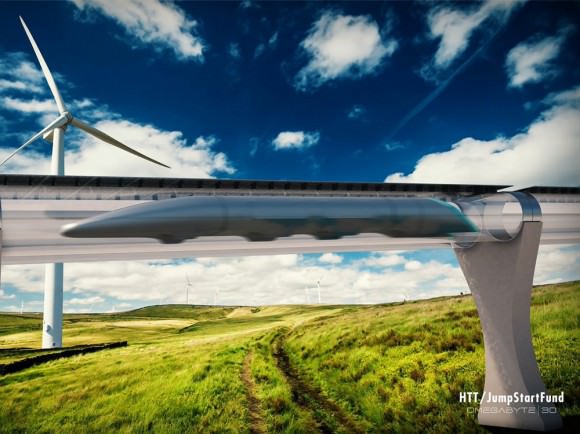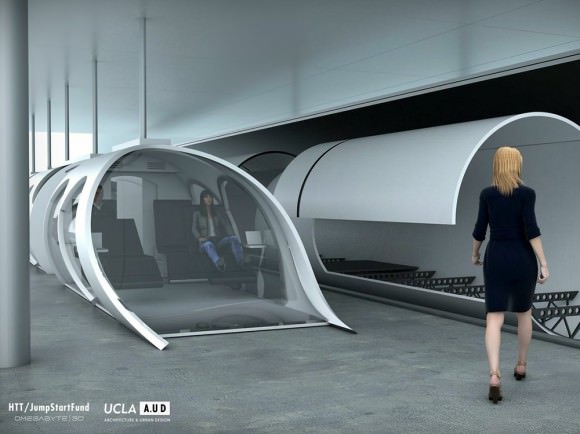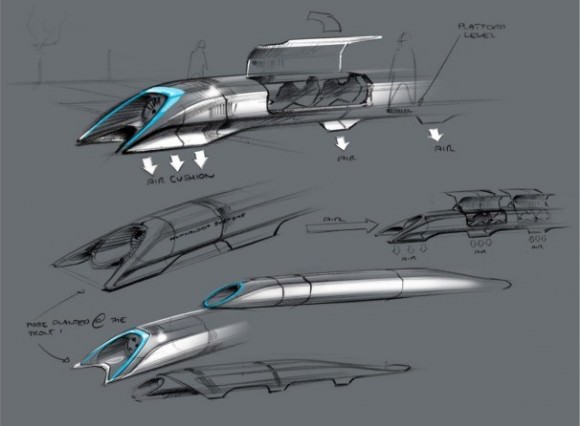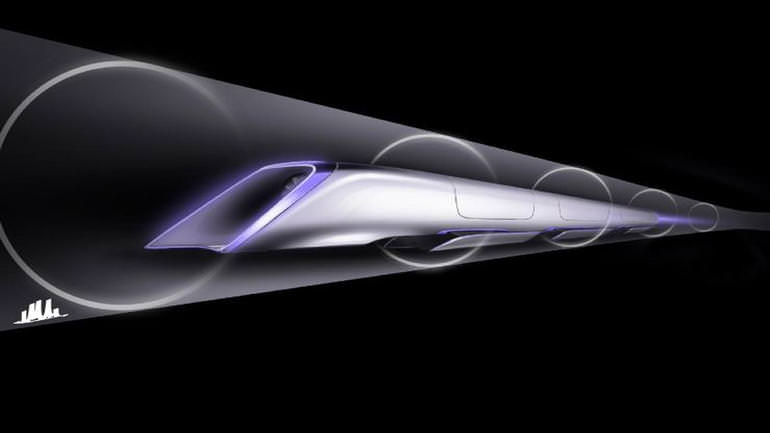Fans of Elon Musk and high-speed transit are sure to remember the Hyperloop. Back in 2013, Musk dropped the idea into the public mind with a paper that claimed that using the right technology, a high-speed train could make the trip from San Fransisco to Los Angeles in just 35 minutes.
However, Musk also indicated that he was too busy to build such a system, but that others were free to take a crack at it. And it seems that a small startup from El Segundo, California is prepared to do just that.
That company is JumpStartFund, a startup that combines elements of crowdfunding and crowd-sourcing to make innovation happen. Dirk Ahlborn, the CEO of JumpStartFund, believes they can build Musk’s vision of a solar-powered transit system that would transport people at up to speeds of 1280 km/h (800 mph).
Together with SpaceX, JumpStartFund has created a subsidiary called Hyperloop Transportation Technologies (HTT), Inc. to oversee all the necessary components to creating the system. This included bringing together 100 engineers from all over the country who work for such giants of industry as Boeing, NASA, Yahoo!, Airbus, SpaceX, and Salesforce.

Last week, these engineers came together for the first time to get the ball rolling, and what they came up with a 76-page report (entitled “Crowdstorm”) that spelled out exactly how they planned to proceed. By their own estimates, they believe they can complete the Hyperloop in just 10 years, and at a cost of $16 billion.
A price tag like that would be sure to scare most developers away. However, Ahlborn is undeterred and believes that all obstacles, financial or otherwise, can be overcome. As he professed in an interview with Wired this week: “I have almost no doubt that once we are finished, once we know how we are going to build and it makes economical sense, that we will get the funds.”
The HTT report also covered the basic design and engineering principles that would go into the building of the train, as Musk originally proposed it. Basically, this consists of pods cars that provide their own electricity through solar power, and which are accelerated through a combination of linear induction motors and low air pressure.
Much has been made of this latter aspect of the idea, and has often compared to the kinds of pneumatic tubes that used to send messages around office buildings in the mid-20th century. But of course, what is called for with the Hyperloop is bit more sophisticated.

Basically, the Hyperloop will operate by providing each capsule with a soft air cushion to float on, avoiding direct contact with rails or the tube, while electromagnetic induction is used to speed up or slow the capsules down, depending on where they are in the transit system.
However, the HTT engineers indicated that such a system need not be limited to California. As it says in the report: “While it would of course be fantastic to have a Hyperloop between LA and SF as originally proposed, those aren’t the only two cities in the US and all over the world that would seriously benefit from the Hyperloop. Beyond the dramatic increase in speed and decrease in pollution, one of the key advantages the Hyperloop offers over existing designs for high-speed rail is the cost of construction and operations.”
The report also indicated the kind of price bracket they would be hoping to achieve. As it stands, HTT’s goal is “to keep the ticket price between LA and SF in the $20-$30 range,” with double that amount for return tickets. But with an overall price tag of $16 billion, the report also makes allowances for going higher: “[Our] current projected cost is closer to $16 billion,” they claim, “implying a need for a higher ticket price, unless the loop transports significantly more than 7.4 million annually, or the timeline for repayment is extended.”
In addition, the report also indicates that they are still relying heavily on Musk’s alpha document for much of their cost assessment. As a result, they can’t be specific on pricing or what kinds of revenues the Hyperloop can be expected to generate once its up and running.

Also, there’s still plenty of logistical issues that need to be worked out, not to mention the hurdles of zoning, local politics and environmental assessments. Basically, HTT can look forward to countless challenges before they even begin to break ground. And since they are depending on crowdfunding to raise the necessary funds, it is not even certain whether or not they will be able to meet the burden of paying for it.
However, both Ahlborn and the HTT engineering team remain optimistic. Ahlborn believes the financial hurdles will be overcome, and if there was one thing that came through in the team’s report, it was the belief that something like the Hyperloop needs to happen in the near future. As the team wrote in the opening section of “Crowdstorm”:
“It quickly becomes apparent just how dramatically the Hyperloop could change transportation, road congestion and minimize the carbon footprint globally. Even without naming any specific cities, it’s apparent that the Hyperloop would greatly increase the range of options available to those who want to continue working where they do, but don’t wish to live in the same city, or who want to live further away without an unrealistic commute time; solving some of the major housing issues some metropolitan areas are struggling with.”
Only time will tell if the Hyperloop will become the “fifth mode of transportation” (as Musk referred to it initially) or just a pipe-dream. But when it was first proposed, it was clear that what the Hyperloop really needed was someone who believed in it and enough money to get it off the ground. As of now, it has the former. One can only hope the rest works itself out with time.
Further Reading: JumpStartFund, SpaceX/Hyperloop, Crowdstorm


Whoa Nelly! Can you imagine what looking out the window of a ‘Hyperloop’ traveling at 800 mph that close to the ground would look like? YIKES! Close the drapes.. I think I’m gonna hurl!
Aqua, you are funny. Yep, these “pneumatic tubes” won’t have any windows and probably will rely on flat screen views which can control the refresh rate of the scenery flashing by. Like Back to the Future – “Roads? Where we’re going, we don’t need roads.” These tubes don’t need windows. And hopefully they’ll solve the problem of snapping ones head off, dropping it off in Bakersfield during an emergency stop.
Ahh… now I see.. the transparent conduits/tubes are for illustration only. Duh… sheepish grin.
Solar powered? So it will stop in the afternoon?
This won’t fly. I think it’s a spin off of his grand Martian colonization scheme. Rockets, spaceships, solar power, batteries, electric vehicles are all focused on use on Mars. Elon Musk is serious. The crowdfunded fraudsters, not so much.
It very much is. While a hyperloop on Earth is interesting and may – may – end up being financially viable, it isn’t a necessity. On Mars it is. Everything Musk has done in the past decade has been Mars focused, in retrospect. Batteries, electric vehicles, methane rocket engines, reusable rockets, cheap solar power, and pushing forward crewed spaceflight. All focused on Mars.
Good idea, really, really bad location.
If it runs from Los Angeles to San Francisco, they can call it the San Andreas Fault Memorial Hyperloop.
Better to built it on the Eastern seaboard.
Elan Musk claims that the Hyperloop would be completely earthquake safe, though he admitted on a press call: “If LA falls down, well then I guess the Hyperloop would too.”
Source: http://www.fastcoexist.com/1682841/heres-what-elon-musks-high-speed-hyperloop-will-look-like
> Better to built [sic] it on the Eastern seaboard.
No.
How about from Phoenix to Vegas? I like that idea much more. Stable. Flat (well, except for the grand canyon part – but that section will entertain the engineers….). Not currently directly connected by a major US highway, either.
Been thinking further about an earthquake while riding along at 800 mph in a tube. The greatest vertical acceleration recorded in California was in Petrolia in 1992 @ 1.85 g’s. Maybe there should be skids on the roof too?
I remember reading about it. A D-8 tractor was thrown up into the air and landed fifteen feet away… twice.
Is there ANY way to get rid of the likes of Inat1972???????
Oops!
Sorry.
I guess Inat’s gone.
THANKS!
(I like Phoenix to Vegas.)
Like all ‘break the mould’ ideas, it is revolutionary. There clearly are many matters that need to be resolved, like creating sufficient electrical energy through solar power – from sunlight through a transparent tube! That’s going to need super efficient solar panels. And who is going to clean the inside and outside of these transparent tubes – buildup of grime is inevitable, especially greasy grime on the inner side of the tubes. Then of course there is the question of passenger comfort and safety. Acceleration will need to be no more that, say, that experienced during take-off on a commercial jet, but for much longer. And, of course, there is no way around physics – a true emergency stop would bring catastrophic forces into play, with the unfortunate effect of body parts parting company.
But I’m sure these and other problems will yield to the combined intellectual force of America’s finest brains. Good luck and best wishes.
The tubes aren’t going to be transparent. That’s for demonstration purposes only.
The tubes also are going to be in a vacuum (or extreme low pressure). No need for grease or anything else to get inside of them.
The majority of energy needed to travel faster than sound is used to push air out of the way. With almost no air resistance, there is no terminal velocity needing energy to push beyond. A relatively small amount of energy could accelerate these pods to 800mph. The biggest question is how fast do you want the pods to accelerate? They could accelerate at 1g. And then the biggest time savings would only be in cross country type transit. Or they could accelerate at 4g and make shorter trips more economical. But if you read, the solar power (batteries) on the cars would be basically for environmental control rather than movement. They would recharge while at the stations. It would be the permanent fixed stations which would supply the power for induction (movement) of the pods.
By my calculations, at 1g it would take around 36 seconds to accelerate to 800mph, over a distance of just over 6km. Just fine for short trips.
There has been talk of a similar system from the Eastern Seaboard of U.S.A. to Europe how cool is that? Wales to New York in less than 4 hours….. You Americans can come over and watch real football and us Europeans can pop over to watch some good baseball…sounds good to me 🙂 Merry Christmas all.
Now, now. When Americans want to watch real football, “they” either go to Seattle, Argentina or Canada, where contrary to the popular belief, “we” do have four downs but punt on the third one, just to give the opponents a chance … 😉